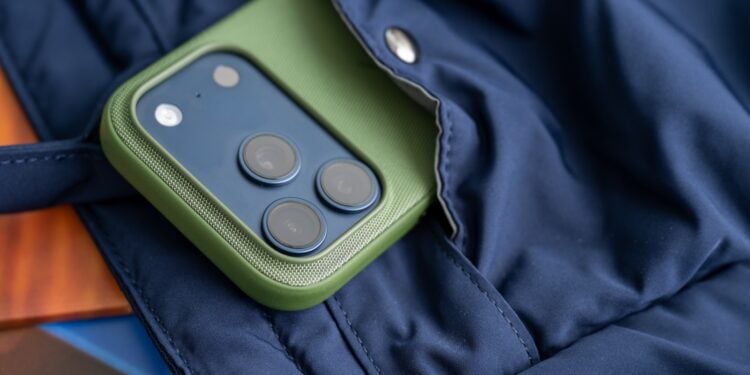Apple is exploring new ways to integrate accessories and the iPhone more closely. A recent rumor from China and previous company patents suggest that future iPhone cases will offer significantly more than just protection. Touch-sensitive layers in official cases could take over functions that were previously performed by mechanical or capacitive buttons on the device itself.
Apple has been reducing physical elements on the iPhone for years, increasingly shifting traditional controls to software and sensors. If the company is indeed planning a virtually bezel-less iPhone, it will need new solutions for basic interactions. Interactive cases could be just the right addition to make a buttonless design practical.
Apple is testing touch-sensitive layers in official cases
A well-known Chinese leaker, Instant Digital, reports that Apple is working on official iPhone cases that will function as a second touch surface. The cases are said to contain integrated sensor layers that respond to touch. According to the leaker, the development is aimed at upcoming Pro models, though no technical details were provided.
Patent application shows Apple's approach as early as 2024
A patent application from 2024 describes a case with an input function for an electronic device. Apple outlines an iPhone case that not only protects the device but also serves as an active input surface. The document mentions touch-sensitive areas in the case that utilize capacitive or pressure-based sensors. These zones are intended to trigger actions that are normally controlled via the iPhone's physical buttons.
Once the case is attached, the iPhone recognizes it and redirects button functions to the case. Tapping, pressing, or swiping on the outside can then trigger system processes such as volume adjustments or camera functions.
Communication between case and device
The patent describes in detail how the case communicates with the iPhone. Interfaces such as NFC for identification and signal transmission are mentioned. Some versions even include provisions for biometric input. This would make it conceivable that a Touch ID fingerprint sensor could be integrated directly into the case and thus used again as an unlocking method.
Connection to Apple's plans for a bezel-less iPhone
Rumors suggest that Apple is planning a radically new design for the iPhone's 20th anniversary. The display is expected to wrap around all four edges of the device. Mechanical buttons would have little room in such a design. Reports also point to a possible transition to fixed capacitive layers that eliminate the need for mechanical components, thus enabling a visually seamless device.
An interactive case would fit into this concept. Controls could be moved to larger and more ergonomically advantageous areas of the case. At the same time, accidental input at the display edges of an all-screen design could be reduced.
Advantages of a case with touch zones
A case with integrated sensor areas can perform multiple functions. It can shift volume and camera shutter controls to larger areas, offering improved accessibility and reducing accidental inputs. It can provide tactile feedback that would be missing on an edge-to-edge iPhone. Furthermore, it could enable new operating concepts that traditional buttons cannot replicate, such as gestures across the entire side surface.
Possible connection to the anniversary model
Whether Apple is developing these interactive cases specifically for the anniversary model remains unconfirmed. However, the combination of patents, rumors, and the expected radical design change makes the idea plausible. The next major iPhone, expected in fall 2027, could be a device that integrates accessories and hardware much more closely than before.
Accessories are used to extend iPhone control.
All indications suggest that Apple is intensively researching how an iPhone case can serve as an extension of the user interface. With the prospect of a nearly bezel-less device, this approach is gaining importance. An interactive case could compensate for the lack of physical buttons, open up new ways of interacting with the device, while maintaining the clean and streamlined design of a future iPhone. If Apple pursues this path, the case will not just be an accessory, but an integral part of the user experience. (Image: Shutterstock / Anna Hoychuk)
- Apple Fitness+ in focus for possible subscription changes
- Tesla and Apple CarPlay: How concrete is the support really?
- iPhone future: Apple switches to semi-annual releases
- A 2026 model was never planned for the iPhone Air.
- Mac Pro future uncertain: Mac Studio takes the lead
- Tim Cook could step down as CEO of Apple in 2026.
- iPhone 16e stuck: Apple is banking on a more powerful iPhone 17e
- The iPhone 18 Pro Max could be the heaviest iPhone ever.
- iPhone Air 2 coming later: Apple plans dual camera
- iPhone 18 Pro: Apple redesigns back and materials
- iPhone Air 2 allegedly delayed – what's behind it
- Apple plans to release desktop Macs with M5 chips by mid-2026.
- iOS 27 brings three new AI features to the iPhone
- Apple plans a bezel-less iPhone in 2027 without a visible camera.
- Apple Fitness+: Weak numbers force Apple to rethink its approach
- New MacBook Pro: OLED design only for M6 Pro and M6 Max
- Apple is working on new satellite features for iPhones.
- iPhone 18 Pro could get satellite 5G from SpaceX
- iPhone 18 Pro: Front camera with a smaller display hole?
- iPhone Fold: First details about the under-display camera
- Apple faces rising costs: TSMC makes chips significantly more expensive
- iPhone Air 2026: Will the ultra-thin model come with a dual camera?
- Apple plans billion-dollar deal with Google for new Siri AI




